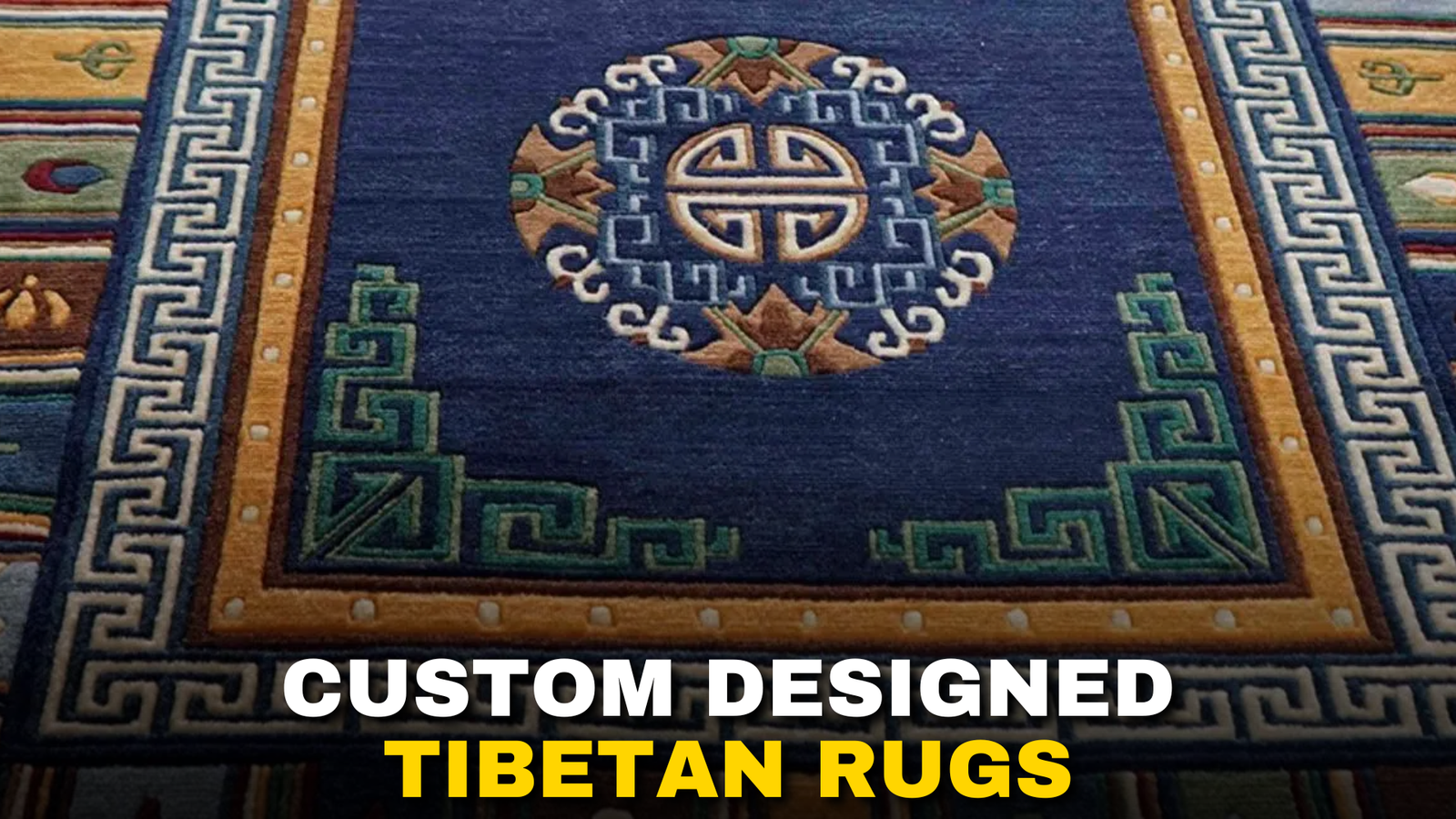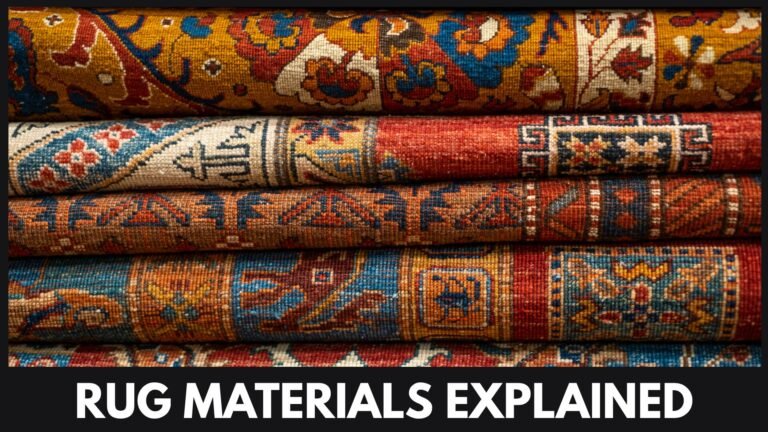
Tibetan Rugs: A Detailed Look into Their History, Craft, and Modern-Day Relevance
Tibetan rugs have a long and fascinating story, even though people in the West only started noticing them in the late 19th century. For many years, they were thought to be similar to Chinese carpets or heavily influenced by weaving traditions from neighboring regions. Yet, the techniques and cultural background of Tibetan carpets hold a unique place in the world of handmade rugs. This blog aims to shed light on their history, how they are made, their significance, and their role today in places like India and Nepal. Along the way, we will also share how we at Carpetsandrug offer custom area rugs that honor time-tested methods while catering to modern tastes.
Table of Contents
1. Early Recognition in the West
It wasn’t until the 1880s that Western collectors first started to appreciate Tibetan carpets as distinct items. Before that, they were often mislabeled as Chinese because many art enthusiasts could not easily differentiate between Tibetan and Chinese designs. The late recognition also came from a lack of written records about the Tibetan carpet trade, making it tricky for researchers to piece together a clear timeline.
Despite this late appearance in global markets, the art of rug-making in Tibet has existed for centuries. Weavers in Tibet relied on skills passed down through generations, using local resources and traditional patterns. Over time, historical and political events in Tibet limited large-scale rug production, causing delays in wide-scale trade and recognition.
2. The Decline and Revival of the Tibetan Rug Industry
During the 19th and early 20th centuries, Tibetan carpets became more common in local markets. However, by the second half of the 20th century, various changes—both within Tibet and worldwide – led to a slowdown in the industry. After political shifts in the region, many Tibetans fled to neighboring countries. This movement of people contributed to the spread of Tibetan rug-making skills beyond Tibet.
In the 1970s, Tibetan carpet weaving experienced a revival, but this new surge occurred mainly in Nepal and India. As refugees settled in these countries, they continued weaving, teaching newcomers the craft, and establishing a fresh environment where production could grow. As a result, today’s Tibetan-style rugs mostly come from workshops in Nepal and certain parts of India.
3. Materials: Changing Sources of Wool
Although many people believe that Tibetan rugs are woven from the wool of Tibetan Highland sheep, modern realities are more complicated. Tibetan Highland sheep’s wool, known as “changpel,” was once the primary fiber for these rugs. It is strong, naturally insulating, and offers a unique texture. However, political restrictions and high costs make importing Tibetan wool challenging. As a result, rug makers in Nepal and India often rely on wool from countries like New Zealand.
New Zealand wool is widely available and praised for its consistent quality. It also keeps costs under control, ensuring weavers can continue their work without interruption. Meanwhile, for those who prioritize authenticity, some rugs still incorporate Tibetan wool when it is accessible. Carpets made with genuine Tibetan wool can be more expensive, but many collectors consider it a worthwhile investment.
4. Practical Uses of Tibetan Carpets
Tibetan carpets serve many purposes, both historical and modern. The most obvious use is flooring, as rugs offer warmth in high-altitude environments. However, they are not limited to just covering the floor. In traditional Tibetan households, you might find rugs on walls for insulation or as decorative hangings. They have also been used as horse saddles due to their durable nature.
People in Tibet commonly use seating carpets and sleeping rugs, also called khaden, for comfort. Meanwhile, some items such as pile rug pillows were once seen as symbols of higher social standing, making them less accessible to everyone. Throughout history, the main focus of Tibetan rugs has been practicality, with beauty and design serving as additional benefits.
5. Traditional Dyes and Modern Colors
In older Tibetan rug-making, natural dyes were the main source of color. The most frequently used were madder (for red), indigo (for blue), Tibetan rhubarb (for yellow), and walnut (for shades of brown and grey). These dyes gave a subdued yet striking color palette that matched the rugged environment of Tibet.
As time went on, chemical dyes became easier to obtain. This led to a wider selection of colors and the possibility of more varied designs. Today, you can find Tibetan-style rugs with both natural and synthetic dyes. Many rug enthusiasts prefer naturally dyed pieces for their organic tones and cultural authenticity. Others enjoy the bright and more diverse range of colors provided by synthetic dyes.
6. Popular Motifs and Their Meanings
Tibetan rugs have always displayed meaningful symbols, often inspired by religious or cultural beliefs. The vajra, for example, is frequently seen and represents spiritual enlightenment in Buddhism. Another symbol is the ancient swastika, which, in the Tibetan context, has been a positive emblem associated with good fortune and well-being for centuries.
Animals hold special places in Tibetan rug patterns. You might come across designs featuring the phoenix and dragon together, both representing luck and benevolence. Cranes are also popular because they are considered a sign of good fortune. The snow lion is a highly admired mythical creature in Tibetan culture, symbolizing courage and joy. And let’s not forget the famous tiger rugs—these once served as visual demonstrations of status and wealth. They also carried spiritual importance, since a tiger pelt (or a rug resembling one) was believed to offer extra protection during meditation.
7. The Modern Scenario in Nepal and India
As mentioned, rug-making migrated largely to Nepal and India from the 1970s onward. Tibetan diaspora communities brought their techniques and knowledge, helping to build well-established weaving centers. In Nepal, especially in Kathmandu, many workshops produce Tibetan-style carpets for the international market. Weavers carefully preserve traditional knotting methods, while business owners adapt to worldwide consumer preferences. India has also become a valuable hub for manufacturing these rugs, with many skilled artisans carrying on the craft.
Carpetsandrug sources custom area rugs from artisan communities where age-old weaving practices meet modern demands. This network supports weavers by offering fair wages and ensuring traditional approaches are not lost in the fast-paced global market. At the same time, these collaborations allow clients to order rugs that suit contemporary interiors without losing the sense of tradition.
8. Reasons to Consider a Tibetan-Style Rug in Your Home
- Rich Cultural Background: Bringing a Tibetan-style rug into your home means adding a piece of history and culture to your décor. Their patterns hold a deeper meaning, carrying stories that go back generations.
- Durable Construction: Tibetan rugs, whether made with Tibetan Highland wool or imported wool, are known for their sturdy texture. They can handle regular foot traffic and are suitable for living rooms, bedrooms, or hallways.
- Unique Aesthetic: Traditional motifs can give your space a special look, while modern adaptations can match more varied interior styles. Whether you prefer classic designs or contemporary patterns, Tibetan rugs offer plenty of choice.
- Ethical Production: Many of these rugs support weaving communities in Nepal and India. By choosing authentic pieces from reliable sources, you help maintain an art form and encourage fair labor practices.
- Flexible Sizes and Shapes: Tibetan rugs come in different dimensions, from large carpets to smaller seat covers. If you need custom area rugs, companies like Carpetsandrug can create pieces based on your preferences.
9. Methods and Knotting Techniques
One characteristic feature of Tibetan rugs is the “Tibetan knot,” which differs from Persian or Turkish knots. Artisans use a rod to form knots, wrapping yarn around the warp threads on the loom. After weaving a row, they cut the looped yarn, creating the rug’s pile. This technique allows weavers to move quickly and produce rugs with a dense, soft surface.
Though modern workshops may use updated tools for efficiency, the core process remains deeply rooted in tradition. This blend of old and new helps rug-makers keep pace with demand while preserving original craftsmanship.
10. Rug Care and Maintenance
Taking care of any handmade rug ensures it remains beautiful and long-lasting. With Tibetan carpets, the high-quality wool and knotting methods make them quite durable, but proper care is still crucial. Here are a few tips:
- Regular Vacuuming: Use a vacuum cleaner (without a rotating brush) to remove dirt and debris from the surface. This helps keep the fibers fresh and prevents particles from settling deep into the pile.
- Rotate Occasionally: Give the rug an even exposure to foot traffic and sunlight by rotating it every few months. This simple step helps avoid uneven fading and wear.
- Prompt Stain Removal: If spills happen, blot the area immediately with a clean cloth. For persistent stains, use mild soap and water or consult a rug-cleaning specialist familiar with wool rugs.
- Air It Out: In humid climates, allow your rug to air out occasionally. This prevents moisture buildup and the growth of mildew.
- Professional Cleaning: A professional cleaning at least once every couple of years can help maintain the rug’s overall appearance and fiber health.
11. How Carpetsandrug Supports This Tradition
At Carpetsandrug, we believe in upholding traditional rug-making practices while offering modern designs and custom area rugs to suit different spaces. Our goal is to make sure every rug tells a story of skill and care. Our close collaboration with weaving communities in Nepal and India helps us deliver rugs that maintain the essence of Tibetan craftsmanship:
- Custom Designs: We work closely with artisans to develop patterns that honor cultural motifs and meet various design preferences. Whether you want a classic Tibetan motif or a more updated pattern, we cater to your needs.
- Responsible Sourcing: We try to use wool from trusted suppliers to ensure quality and fair prices. Some rugs are made from Tibetan Highland wool if available, but we also rely on other sources when needed.
- Supporting Weavers: By partnering with dedicated weaving centers, we contribute to local economies and ensure that younger generations learn and continue weaving skills.
- Quality Assurance: Each carpet undergoes multiple checks, from the initial design to the final product. We want to confirm that you receive a rug that remains both beautiful and durable.
For us, handmade rugs are not just floor coverings but a link between past and present. When you choose a Tibetan-style piece from our collection, you bring a piece of that heritage into your own living space. If you need something tailored to your exact size or color preference, our custom area rugs service is the perfect fit.
12. The Cultural Significance of Tibetan Rugs
Tibetan rugs were always part of daily life in Tibet. Their utility ranged from seating to decoration, and sometimes even religious or meditative contexts. The climate of Tibet, with its cold weather, made thick woolen rugs necessary for warmth and comfort. Over time, however, they came to represent more than just functionality. They served as status symbols, works of folk art, and reminders of spiritual beliefs.
The motifs woven into Tibetan carpets often connect to faith and mythology. Dragons, snow lions, and other symbols signal messages of hope, bravery, and auspiciousness. Meanwhile, the presence of religious icons like the vajra shows a deeper spiritual link. Even as Tibetan carpets have moved into global markets, these themes persist, reminding us of their roots.
13. Broader Impact of the Tibetan Diaspora
Many Tibetans left their homeland in 1959, but they did not abandon their identity or their traditional crafts. In India and Nepal, Tibetan refugees set up weaving workshops, shared their skills with younger generations, and began to sell their carpets worldwide. Over time, buyers noticed the unique workmanship and cultural significance of these rugs, contributing to growing demand.
Kathmandu eventually became a key area for Tibetan rug production, with several workshops run by Tibetan families and their descendants. Similar communities exist in parts of India, where displaced Tibetans also settled. Although the craft started in Tibet, these new settings allowed it to adapt and thrive. Today, these weavers continue creating rugs that reflect a blend of original Tibetan methods and influences from their current surroundings.
14. Placing Tibetan Rugs in Modern Interiors
Even though Tibetan carpets have a long history, they can easily fit into many modern Indian homes. Some people choose rugs with lively mythological creatures as a focal point in a neutral space. Others prefer more subtle designs that blend into an already colorful room. Either way, Tibetan-style rugs add warmth and texture, thanks to the soft wool used in their production.
If you are decorating a living room, a larger Tibetan carpet can cover the main floor area, creating an inviting environment. In bedrooms, a smaller rug on each side of the bed offers comfort. For hallways, a runner can protect high-traffic areas and bring a dash of personality. The patterns, whether traditional or slightly updated, mix well with wooden, tiled, or even stone floors.
15. Conclusion
Tibetan carpets have endured countless shifts, from political challenges in their homeland to evolving tastes in global markets. Their continued presence proves that a strong cultural craft can survive through creativity, skill, and dedication. Weavers who settled in Nepal and India carry on time-honored methods, often with new materials or dyes, but always with deep respect for their heritage.
At Carpetsandrug, we admire the practicality and artistry of Tibetan-style rugs. We present options that connect ancient techniques with current interior trends, making sure our customers receive both quality and authenticity. Our custom area rugs reflect local skills and personal choices, so you can have a piece that fits perfectly into your living or work space. By selecting a Tibetan-inspired carpet, you add a sense of tradition, comfort, and cultural heritage to your everyday surroundings.
FAQs (Frequently Asked Questions)
- Why did Tibetan rug production shift to Nepal and India?
After political changes in Tibet, many weavers moved to neighboring countries. They set up workshops and continued weaving there, creating new centers for Tibetan-style carpet production. - Is Tibetan Highland sheep’s wool still used?
Yes, but it is limited and expensive because of import restrictions. Many workshops now rely on wool from places like New Zealand for greater availability and affordability. - What makes Tibetan rugs different from other handmade carpets?
Tibetan weavers use a unique knotting method that involves looping yarn around a rod, then cutting it to form the pile. This technique gives the carpets a thick and soft texture. - Do Tibetan carpets carry any religious value?
Certain patterns and symbols, such as the vajra or snow lions, can represent spiritual beliefs. Although people often buy these rugs for their beauty and comfort, the original motifs can have deeper meanings. - Are natural dyes still used?
Some artisans continue to use traditional dyes like madder, indigo, and Tibetan rhubarb. Others opt for synthetic dyes, which allow a broader range of shades and ensure consistent color results. - How should I clean my Tibetan carpet?
Routine vacuuming, gentle blotting of spills, and periodic airing are recommended. For stubborn stains, a mild cleaning solution or a professional rug cleaner works best. - Can I order a custom-size Tibetan rug?
Yes, many workshops and companies, including Carpetsandrug, offer custom sizes and designs. This allows you to pick the dimensions, color scheme, and motif that match your home. - What are the most popular patterns in Tibetan rugs?
Traditional motifs include geometric shapes, mythological animals like dragons, and religious symbols. Modern twists often feature simpler shapes, abstract elements, or soft color gradations. - Why are older Tibetan rugs harder to find?
Historical records of Tibetan rugs are limited, and many older pieces are in private collections or museums. Political and social challenges in Tibet also led to reduced production and fewer rugs on the open market. - Where can I buy authentic Tibetan-style carpets?
Look for reliable sources that work directly with weavers or established workshops. Carpetsandrug is one such brand that cooperates with skilled artisans to bring you high-quality, ethically produced, custom area rugs.



